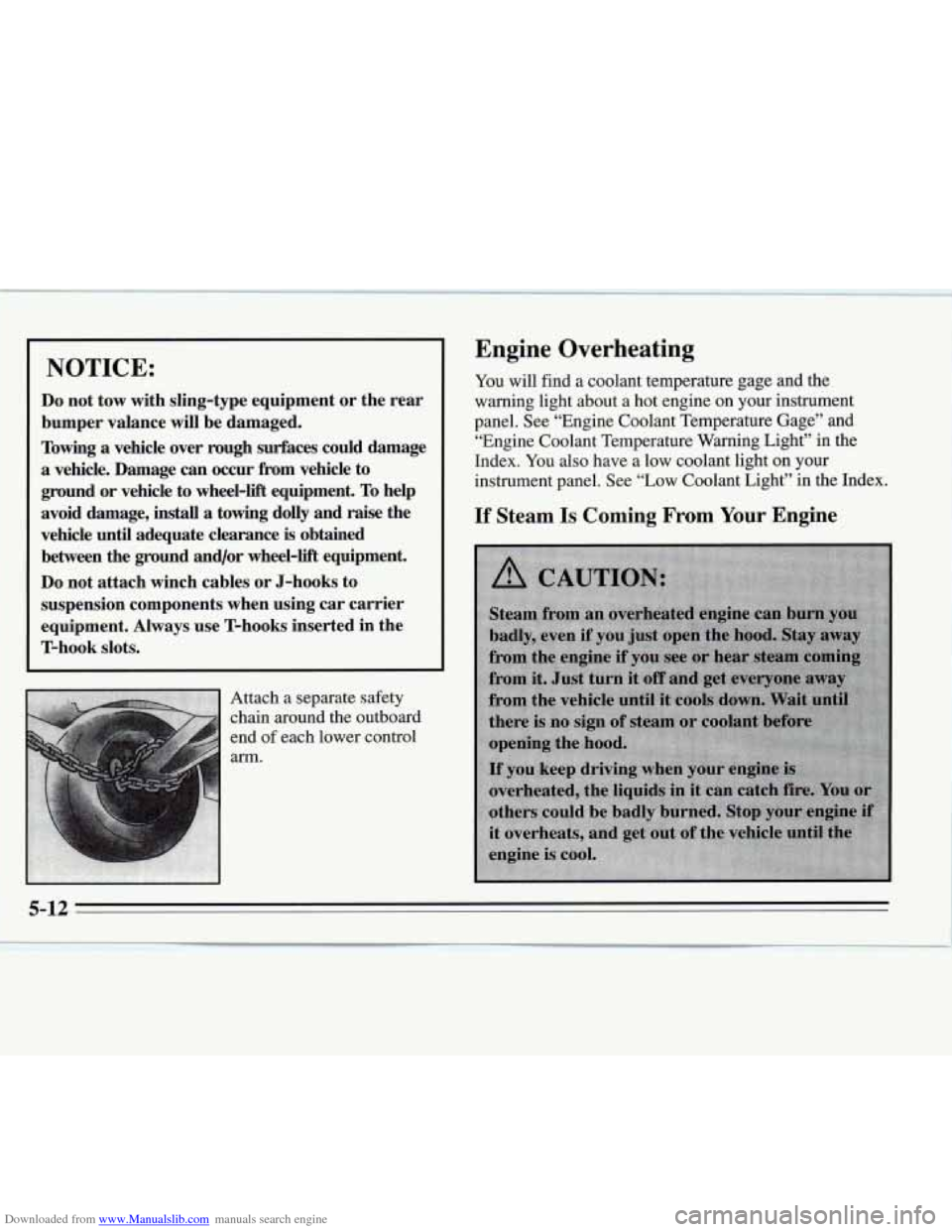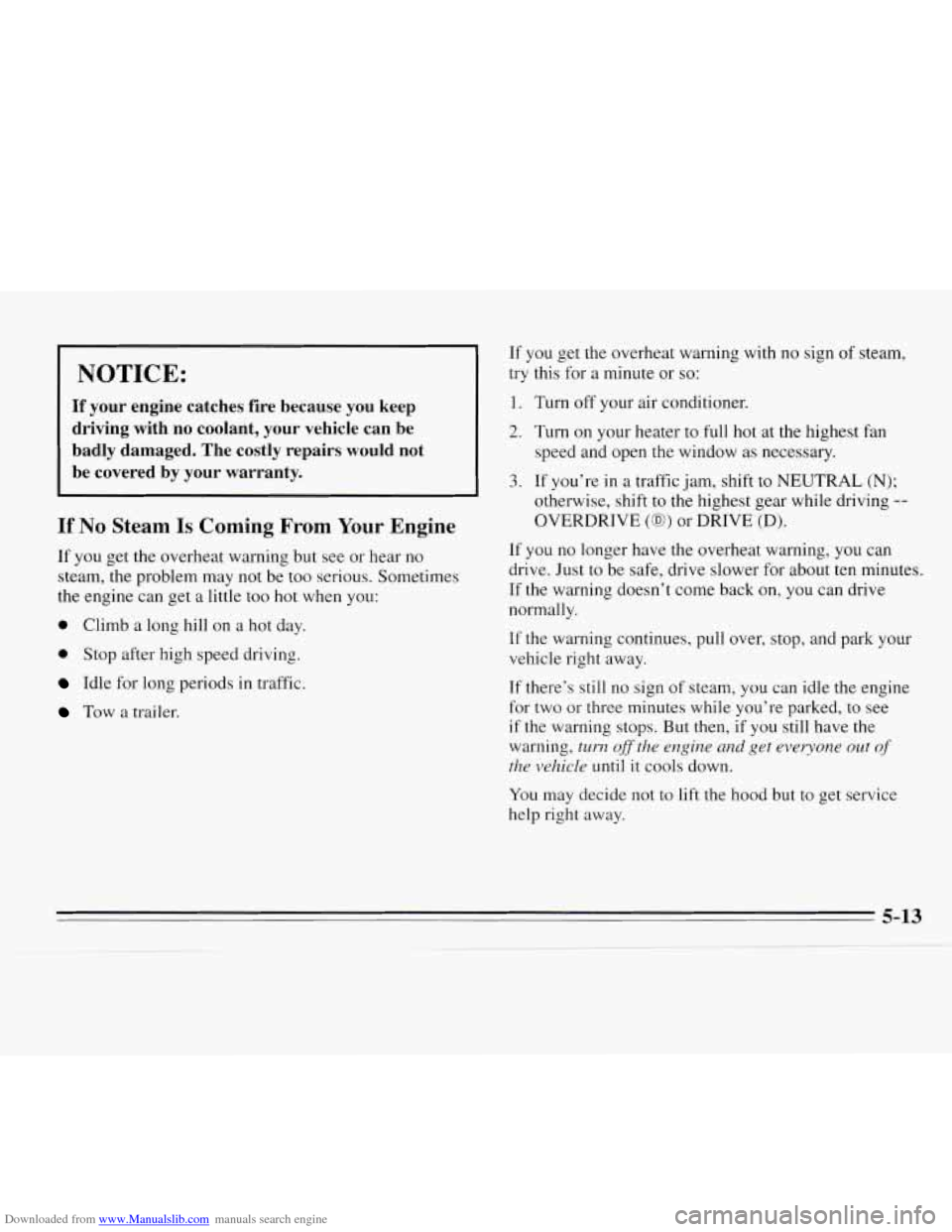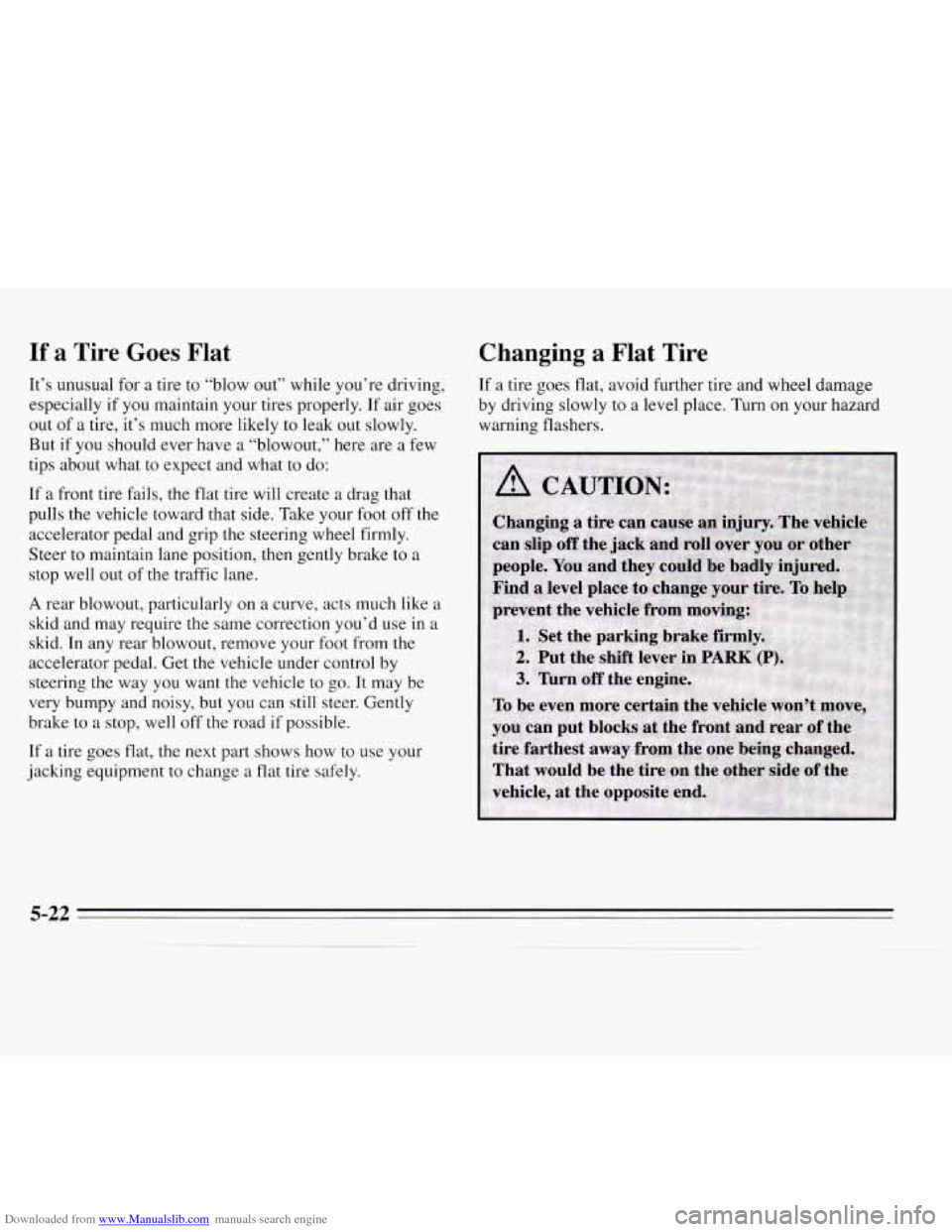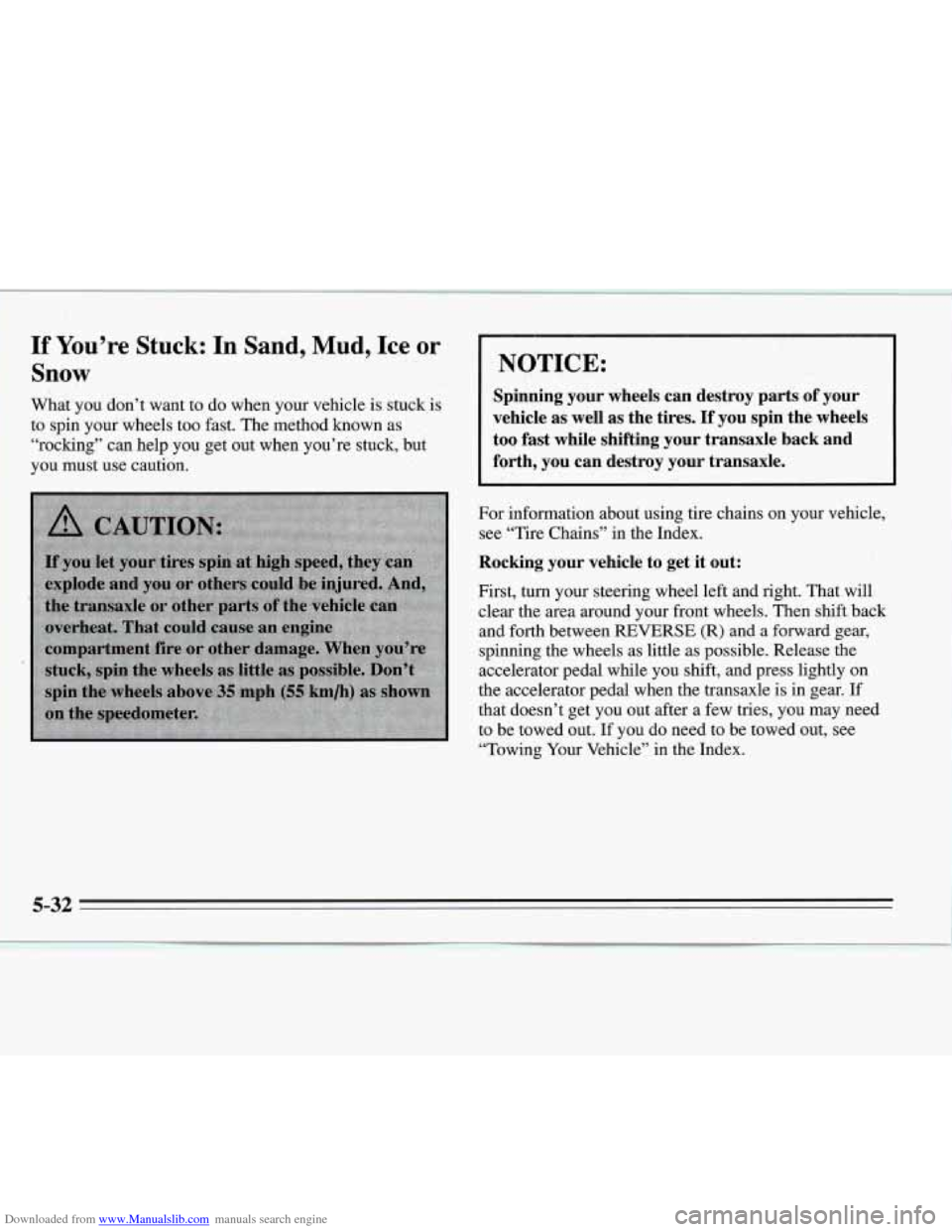Page 172 of 324
Downloaded from www.Manualslib.com manuals search engine Use wheel-lift or car carrier equipment. Additional
ramping may be required
for car carrier equipment. Use
safety chains and wheel straps.
NOTICE:
Do not tow with sling-type equipment or
fascialfog lamp damage will occur.
Towing a vehicle over rough surfaces could
damage a vehicle. Damage can occur from
vehicle to ground
or vehicle to wheel-lift
equipment. To help avoid damage, install a
towing dolly and raise vehicle until adequate
clearance is obtained between the ground and/or
wheel-lift equipment.
Do not attach winch cables or J-hooks to
suspension components when using car carrier
equipment. Always use T-hooks inserted in the
T-hook slots.
5-10
Page 173 of 324
Downloaded from www.Manualslib.com manuals search engine Attach a separate safety
chain around the outboard
end of each lower control
arm.
I I
Rear Towing Hookup
Attach T-hook chains into
the slots in the bottom
of
the floor pan support rails
just ahead
of the rear whee
on both sides. 1s
Use wheel lift or car carrier equipment. Additional
ramping may be required for car carrier equipment. Use
safety chains and wheel straps.
5-11
Page 174 of 324

Downloaded from www.Manualslib.com manuals search engine NOTICE:
Do not tow with sling-type equipment or the rear
bumper valance
will be damaged.
Towing
a vehicle over rough surfaces could damage
a vehicle. Damage can occur hm vehicle to
ground or vehicle to wheel-lift equipment. To help
avoid damage,
install a towing dolly and raise the
vehicle until adequate clearance
is obtained
between the ground and/or wheel-lift equipment.
Do not attach winch cables or J-hooks to
suspension components when using car carrier
equipment. Always use T-hooks inserted
in the
T-hook slots.
Attach a separate safety
chain around the outboard
end
of each lower control
arm.
Engine Overheating
You will find a coolant temperature gage and the
warning light about a hot engine on your instrument
panel. See “Engine Coolant Temperature Gage” and
“Engine Coolant Temperature Warning Light” in the
Index. You
also have a low coolant light on your
instrument panel. See “Low Coolant Light” in the Index.
If Steam Is Coming From Your Engine
5-12
I I
Page 175 of 324

Downloaded from www.Manualslib.com manuals search engine I NOTICE:
If your engine catches fire because you keep
driving with no coolant, your vehicle can be
badly damaged. The costly repairs would not
be covered by your warranty.
If No Steam Is Coming From Your Engine
If you get the overheat warning but see or hear no
steam, the problem may not be too serious. Sometimes
the engine can get a little too hot when you:
0 Climb a long hill on a hot day.
0 Stop after high speed driving.
Idle for long periods in traffic.
Tow a trailer. If you
get the overheat warning with no sign of steam,
try this for a minute or
so:
1. Turn off your air conditioner.
2. Turn on your heater to full hot at the highest fan
speed and open the window as necessary.
otherwise, shift to the highest gear while driving
--
OVERDRIVE (@) or DRIVE (D).
3. If you’re in a traffic jam, shift to NEUTRAL (N);
If you no longer have the overheat warning, you can
drive. Just
to be safe, drive slower for about ten minutes.
If the warning doesn’t come back on, you can drive
normally.
If the waning continues, pull over, stop, and
park your
vehicle right away.
If there’s still no sign
of steam, you can idle the engine
for two or three minutes while you’re parked,
to see
if the warning stops. But then, if you still have the
warning,
turn off the engine and get everyone out of
the vehicle until it cools down.
You may decide not to lift the hood but to get service
help right away.
5-13
Page 184 of 324

Downloaded from www.Manualslib.com manuals search engine If a Tire Goes Flat
It’s unusual for a tire to “blow out” while you’re driving,
especially
if you maintain your tires properly. If air goes
out of a tire, it’s much more likely to leak out slowly.
But if you should ever have a “blowout,” here are a few
tips about what to expect
and what to do:
If a front tire fails, the flat tire will create a drag that
pulls the vehicle toward that side. Take your foot
off the
accelerator pedal and grip
the steering wheel firmly.
Steer to maintain lane position, then gently brake to a
stop well out of the traffic lane.
A rear blowout, particularly on a curve, acts much like a
skid and may require the same correction you’d use in
a
skid. In any rear blowout, remove your foot from the
accelerator pedal. Get the vehicle under control by
steering the way you want the vehicle to go. It may be
very bumpy and noisy, but you can still steer. Gently
brake to a stop, well off
the road if possible.
If
a tire goes flat, the next part shows how to use your
jacking equipment to change
a flat tire safely.
Changing a Flat Tire
If a tire goes flat, avoid further tire and wheel damage
by driving slowly to a level place.
Turn on your hazard
warning flashers.
5-22
Page 189 of 324
Downloaded from www.Manualslib.com manuals search engine Remove any rust or dirt from the wheel bolts, mounting
surfaces and spare wheel. Place the spare
on the wheel
mounting surface.
Replace the wheel nuts with
the rounded end
of the nuts
toward the wheel. Tighten
each nut by hand until the
wheel is held against the
hub.
Page 194 of 324

Downloaded from www.Manualslib.com manuals search engine . .. , ! . . . ’.. .: , ..
If You’re Stuck: In Sand, Mud, Ice or
Snow
What you don’t want to do when your vehicle is stuck is
to spin your wheels too fast. The method known as
“rocking” can help you get out when you’re stuck, but
you must use caution.
>.
I NOTICE:
Spinning your wheels can destroy parts of your
vehicle as well as the tires.
If you spin the wheels
too fast while shifting your transaxle back and
forth, you can destroy your transaxle.
For information about using tire chains on your vehicle,
see “Tire Chains” in the Index.
Rocking your vehicle to get it out:
First, turn your steering wheel left and right. That will
clear the area around your front wheels. Then
shift back
and forth between REVERSE
(R) and a forward gear,
spinning the wheels as little
as possible. Release the
accelerator pedal while you shift, and press lightly on
the accelerator pedal when the transaxle is in gear.
If
that doesn’t get you out after a few tries, you may need
to be towed out. If you
do need to be towed out, see
“Towing Your Vehicle” in the Index.
5-32
Page 205 of 324
Downloaded from www.Manualslib.com manuals search engine 3.4L LQ1 (Code X) Engine
To Check Engine Oil
Pull out the dipstick and clean it with a paper towel or
cloth, then push it back in all the way. Remove it again,
keeping
the tip down, and check the level.
When to Add Oil
If the oil is at or below the upper mark, then you’ll need
to add some oil. But
you must use the right kind. This
part explains what kind
of oil to use. For crankcase
capacity, see “Capacities and Specifications” in
the
Index.
NOTICE:
Don’t add too much oil. If your engine has
so much oil that the oil level gets above the
cross-hatched area that shows the proper operating range, your engine could be damaged.
6-11